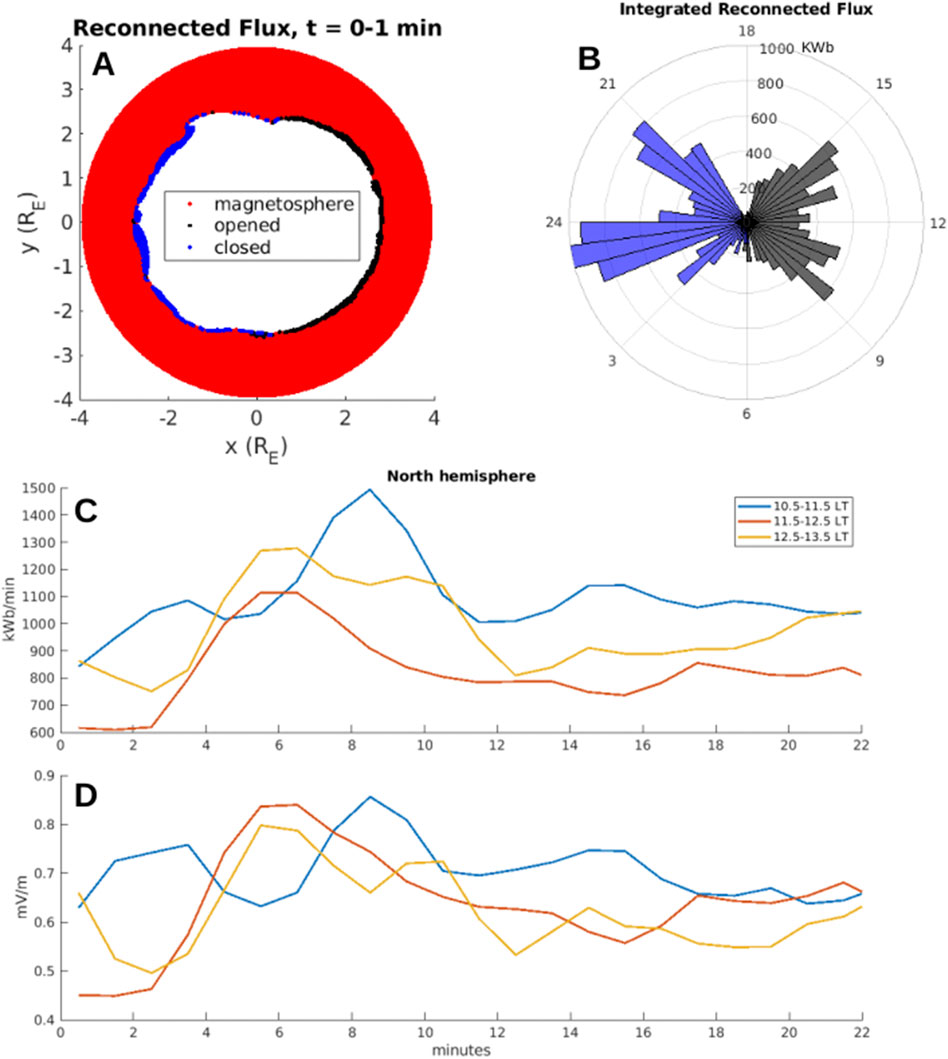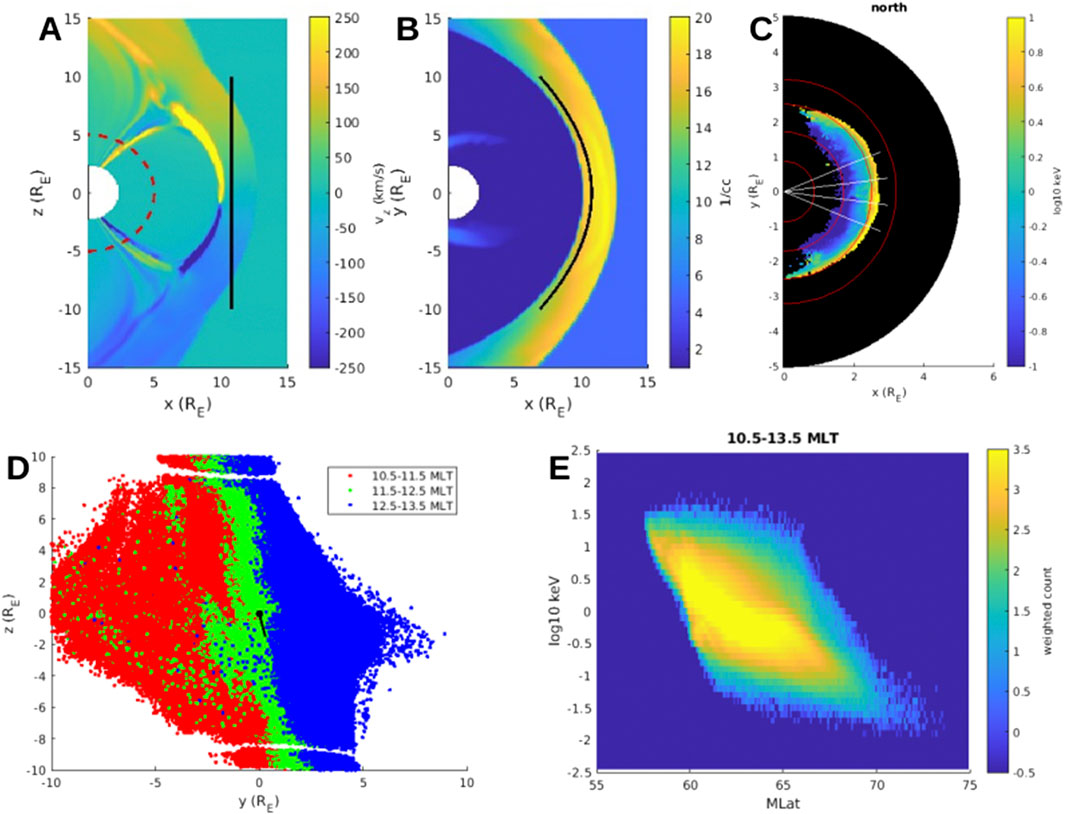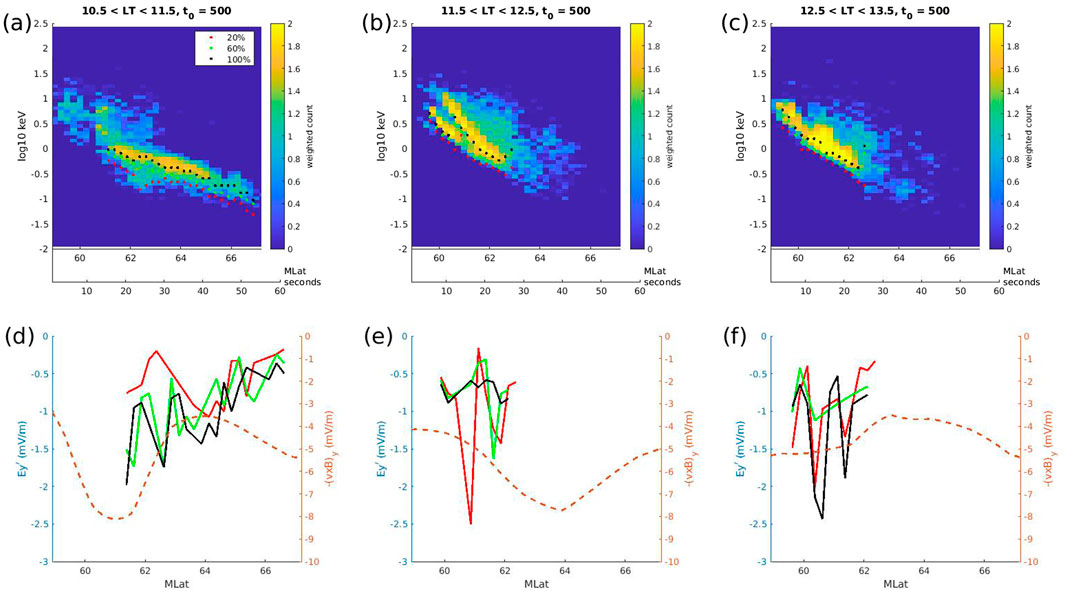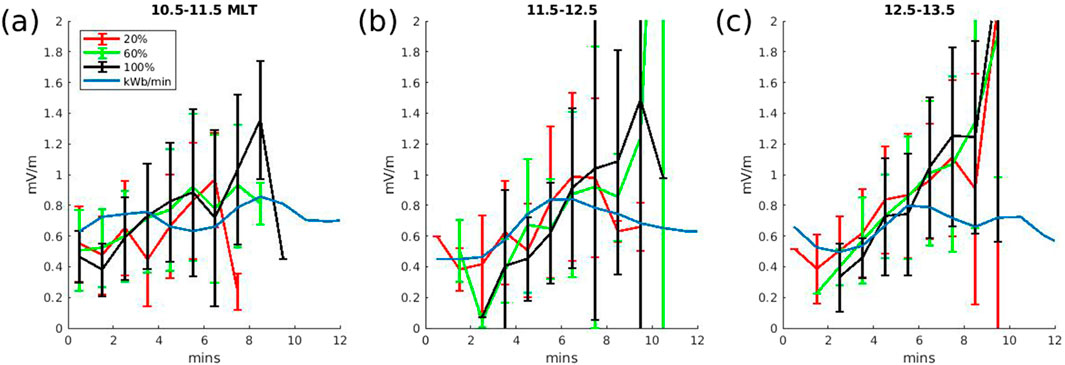- 1Goddard Planetary Heliophysics Institute, University of Maryland Baltimore County, Baltimore, MD, United States
- 2Heliophysics Division, NASA Goddard Space Flight Center, Greenbelt, MD, United States
- 3Center for Space and Atmospheric Research, Embry-Riddle Aeronautical University, Daytona Beach, FL, United States
- 4Catholic University of America, Washington, DC, United States
- 5Department of Astronomy, University of Maryland College Park, College Park, MD, United States
- 6Johns Hopkins University Applied Physics Laboratory, Laurel, MD, United States
When the interplanetary magnetic field (IMF) is southward dominant, antiparallel day-side magnetic reconnection occurs near the equatorial magnetopause, and the reconnection rate quantifies how much magnetic flux is removed from the magnetosphere per time. During space weather events, this is a key quantity to understand, because the day-side magnetopause can be significantly eroded, potentially receding within geosynchronous orbit. However, direct observations of the reconnection rate are challenging, so attempts have been made to quantify the reconnection rate through remote measurements. In particular, ion dispersions observed in the low-altitude cusp have been connected to the day-side magnetopause reconnection rate, assuming the dispersions are formed by time-of-flight differences for different energy particles convecting with the same field line. This provides a promising avenue to probe the day-side reconnection rate with satellites that pass through the low-altitude cusp, like Defense Meteorological Satellite Program (DMSP) and Tandem Reconnection and Cusp Electrodynamics Reconnaissance Satellites (TRACERS). In this study, cusp ion dispersion signatures are constructed using the forward particle tracing capability of the GAMERA-CHIMP global magnetohydrodynamics (MHD) with test particle framework. Under idealized solar wind driving with steady southward IMF, the reconnection rate is calculated and compared with an independent measure of the reconnection rate based on the amount of magnetospheric flux reconnected per time. Changes in magnetospheric flux content indicate the day-side magnetopause reconnection rate is
1 Introduction
Spacecraft flying along the direction of flux tube motion in the low-altitude cusp observe ion time-energy dispersion due to particle entry at the day-side magnetopause and global convection of cusp magnetic field lines. In the case of steady southward interplanetary magnetic field (IMF) orientation, a newly reconnected day-side magnetic field line convects away from the mostly equatorial x-line towards either the northern or southern cusp. This magnetic field line convection mapped to the ionosphere corresponds to motion from low-to-high magnetic latitude (MLat). Faster particles will reach a given altitude in less time than slower particles, so a spacecraft crossing through the cusp will observe higher energy particles on cusp magnetic field lines mapping closer to the x-line (lower magnetic latitude).
Slopes of cusp ion dispersions contain information about the rate of magnetic reconnection on the day-side magnetopause (Lockwood and Smith, 1992). It is noteworthy that the low-altitude cusp can be used to remote sense the day-side magnetopause reconnection rate, because it is far easier to access the low-altitude cusp than the magnetopause x-line. Spacecraft which repeatedly pass through the cusp, like Tandem Reconnection and Cusp Electrodynamics Reconnaissance Satellites (TRACERS, Miles et al. (2025)) and Defense Meteorological Satellite Program (DMSP), thus have the capability to monitor spatiotemporal variations of the reconnection rate. TRACERS will pass through the northern cusp
Some cusp ion dispersions contain spatiotemporal structures such as V-shaped (Woch and Lundin, 1992; da Silva et al., 2022; Xiong et al., 2024) or double ion dispersions (Lockwood, 1995; Trattner et al., 1998; Chandler et al., 2008; Connor et al., 2015; da Silva et al., 2024; Burkholder et al., 2024b). It is not known how well the formalism developed by Lockwood and Smith (1992) applies in such circumstances because steady state reconnection is assumed. Furthermore, fully 3D reconnection topologies (Ouellette et al., 2010) and turbulence (Karimabadi et al., 2013) also affect the day-side reconnection process and thus may play a role in forming the cusp ion dispersions. In this study it is assumed that the Lockwood and Smith (1992) formula can be applied to all the simulated dispersion signatures for an idealized solar wind driving scenario. Since calculating the reconnection rate from simulated cusp ion dispersions has never been attempted before, it is the goal of this paper to establish a methodology to calculate the day-side magnetopause reconnection rate from simulated cusp ion dispersions and validate against an independent measure of the reconnection rate. This lays the groundwork for future application to real events in support of TRACERS mission science. The idealized solar wind driving also provides a useful point of reference to compare with simulated magnetopause reconnection rates during strongly varying and/or intense geomagnetic storm conditions.
2 Calculating the rate of magnetic reconnection
2.1 Change of magnetic flux in global MHD
A 3D Grid Agnostic MHD for Extended Research Applications (GAMERA) simulation (Zhang et al., 2019; Sorathia et al., 2020) of Earth’s magnetosphere was performed to calculate time-dependent magnetic and electric fields under idealized solar driving conditions, the same as Simulation #4 from Burkholder et al. (2023a). The simulation uses Solar Magnetospheric (SM) coordinates, which have the z-axis parallel to Earth’s dipole axis and y-axis perpendicular to the Earth-Sun line. The warped spherical grid has
To determine the reconnection rate in the global magnetosphere simulation, we calculate how much magnetic flux is reconnected per unit time, similar to Ouellette et al. (2010). This study differentiates two reconnection types associated with addition of new magnetospheric flux (night-side reconnection, hereafter “closing reconnection”) or erosion of day-side flux (day-side reconnection, hereafter “opening reconnection”). To calculate these reconnected fluxes, at

Figure 1. (A) Newly reconnected magnetic flux (blue = newly closed, black = newly opened) in the northern hemisphere. Red and white areas correspond to locations where the magnetic field did not undergo a reconnection during the 1-min interval (8:00–8:01). (B) Integration of newly reconnected flux in 30-min MLT bins during the same interval. Black corresponds to integrated newly opened flux and blue corresponds to integrated newly closed flux. (C) Time-dependence of integrated newly opened flux for the MLT sectors 10.5–11.5 (blue), 11.5–12.5 (orange), and 12.5–13.5 (yellow). (D) Reconnected flux (KWb/min) is scaled to electric field (mV/m) by
2.2 Cusp ion dispersion
Forward proton test particle tracing is performed in 3D within the GAMERA fields using the Conservative Hamiltonian Integrator for Magnetospheric Particles (CHIMP, Sorathia et al. (2018)). Since the test particle tracing is performed in the MHD post-processing, the GAMERA fields are evolved in time via interpolation between 5 s outputs. Figure 2 demonstrates the global MHD with test particle simulation setup where ions are initialized in the magnetosheath and collected in the cusp. Figure 2A shows

Figure 2. (A)
The initial energy distribution ranges from 10 eV to 100 eV and pitch angles uniformly distributed from 0–180° (Burkholder, 2025). Particles are weighted (based on their initial energies) against a magnetosheath-like distribution of energies represented by a Maxwellian of temperature 100 eV (on the low end of terrestrial magnetosheath temperatures Shen et al. (2022)). The total number of particles initialized was
Figure 2D shows the initial location of those ions collected at 5
From Lockwood and Smith (1992), the magnetopause reconnection rate
where
Global simulations are necessary to provide the length scales and magnetic field strengths in Equation 1 because these global variables are inaccessible to a single spacecraft. The quantity
Note, the global MHD with test particle approach neglects some physical processes which could modify the simulated ion dispersions (see Drake et al. (2009) for comparison of ion acceleration downstream of the x-line in test particle versus fully kinetic simulations). Specifically, the test particle approach does not include self-consistent feedback between the particles and fields (which can be important for phenomena like solar flares where the number of accelerated particles is sufficiently large, see Zharkova et al. (2011)). Additionally, MHD does not realistically capture the reconnection diffusion region, especially the structure of magnetic field parallel electric fields
3 Results
3.1 Reconnection rate from change of magnetic flux
Figure 1B shows newly opened (black) and newly closed (blue) magnetic flux in 30 min MLT bins (units of kWb represent newly reconnected flux in a 1-min interval). Because the IMF has been steadily southward for 2+ hours, the system has reached a quasi-steady state and there is a symmetry of opening reconnection occurring on the day-side (MLT 6 to 18) and closing reconnection occurring on the night-side (MLT 18–24 and 0–6). At this timestep, the total amount of opened flux is 8,800 kWb and the total amount of closed flux is 9,300 kWb, a difference of less than 3%. Figure 1C shows temporal variation of the simulated reconnection rate in three MLT sectors 10.5–11.5, 11.5–12.5, and 12.5–13.5. It is interesting to note that less flux is almost systematically reconnected at noon MLT compared to pre- and post-noon. Notice also, there are relatively large variations of
Ouellette et al. (2010) calculated the reconnection rate using the Lyon-Fedder-Mobarry (LFM) simulation, the predecessor to GAMERA, and found for purely southward IMF the reconnection rate spanning the entire day-side x-line was
Figure 1 demonstrates that, despite the IMF and solar wind being steady (and having been that way for 2+ hours), there are up to 0.2 mV/m

Figure 3. (a–o) Simulated thermal pressure on the day-side magnetopause (from z = −5 to 5
3.2 Reconnection rate from cusp ion dispersion
Examples of reconnection rates calculated from simulated cusp ion dispersions are shown in Figure 4. The virtual spacecraft was launched at 8:08:20 moving from low to high MLat in the northern hemisphere. The MLat resolution is 0.25° (this is half the bin size of 0.5° so particles are collected in more than 1 pixel per latitudinal step), corresponding to a time resolution of 1.8 s (the time resolution of the TRACERS ion instrument is

Figure 4. Simulated cusp ion dispersions collected by the virtual satellite (with TRACERS-like energy and time resolution) in three different local time bins (a) 10.5–11.5, (b) 11.5–12.5, (c) 12.5–13.5 at
Figure 5 shows a sequence of ion dispersions constructed using a TRACERS-like (d-f) and DMSP-like (a-c,g-i) virtual ion instrument (for simplicity the

Figure 5. (a–i) Simulated cusp ion dispersions in three MLT sectors 10.5–11.5, 11.5–12.5 and 12.5–13.5 (columns). Red dots show
An ion dispersion is constructed with
where
Figures 6a–c show the reconnected flux measure of the reconnection rate for the MLT sectors 10.5–11.5, 11.5–12.5, and 12.5 13.5 (blue, the same as Figure 1d). The colored lines with (1-standard deviation) error bars are the time-delayed ion dispersion calculation of the reconnection rate with a TRACERS-like instrument from 8:08:20–8:12:40 (similar to Figures 5j–l but different colors represent different
Note, units of the ion energy spectrograms (Figures 4, 5) in this study are particle counts/second, which can be converted to differential energy flux (=count rate/geometric factor) to compare with observations. For a geometric factor with no energy dependence, the calculated reconnection rates would be the same regardless of units. However, the TRACERS ACI has an energy-dependent geometric factor (see (Fuselier et al., 2025) Figure 5), such that the ion energy spectrograms in units of differential energy flux have greater flux (compared to spectrograms in units of weighted count) at lower energy. The result of this is to shift

Figure 6. Comparison of the opening reconnection rate (blue) and
4 Discussion and conclusion
The simulated day-side magnetopause reconnection rate based on changes of magnetospheric flux during steady southward IMF has variations of
It is important to note that Equation 1 was developed for the simplified scenario of a spacecraft that follows a single convecting field line during an interval of steady day-side reconnection. Since Figure 1 shows that the reconnection rate varies on
Not only are simulations necessary to determine the relevant length scales for Equation 1, but they provide the means to understand particle trajectories and magnetic reconnection dynamics associated with cusp ion dispersions. This would only otherwise be possible observationally during fortuitous spacecraft alignments. For the steady southward IMF simulation in this study, the parameters
Data availability statement
Test particle simulation outputs are archived at Zenodo (Burkholder, 2025). The global MHD simulation is also archived at Zenodo (simulation 4) (Burkholder, 2023).
Author contributions
BB: Conceptualization, Data curation, Formal Analysis, Funding acquisition, Investigation, Methodology, Resources, Software, Validation, Visualization, Writing – original draft, Writing – review and editing. L-JC: Supervision, Writing – original draft, Writing – review and editing. JD: Writing – original draft, Writing – review and editing. XM: Writing – original draft, Writing – review and editing. DS: Writing – original draft, Writing – review and editing. ID: Writing – original draft, Writing – review and editing. Y-MH: Writing – original draft, Writing – review and editing. NB: Writing – original draft, Writing – review and editing. KS: Writing – original draft, Writing – review and editing.
Funding
The author(s) declare that financial support was received for the research and/or publication of this article. Funding for this work is provided by a NASA Magnetospheric Multiscale (MMS) Early Career Award 80NSSC25K7352.
Acknowledgments
AcknowledgementsWe acknowledge use of the Texas Advanced Computing Center (TACC) at The University of Texas at Austin for providing HPC resources that have contributed to the research results reported within this paper http://www.tacc.utexas.edu. GAMERA-REMIX-CHIMP is part of the Multiscale Atmosphere-Geospace Environment (MAGE) model developed by the NASA DRIVE Science Center for Geospace Storms (https://cgs.jhuapl.edu/MAGE/). We thank the team of the Center for Geospace Storms for providing the GAMERA-REMIX-CHIMP model.
Conflict of interest
The authors declare that the research was conducted in the absence of any commercial or financial relationships that could be construed as a potential conflict of interest.
Generative AI statement
The author(s) declare that no Generative AI was used in the creation of this manuscript.
Any alternative text (alt text) provided alongside figures in this article has been generated by Frontiers with the support of artificial intelligence and reasonable efforts have been made to ensure accuracy, including review by the authors wherever possible. If you identify any issues, please contact us.
Publisher’s note
All claims expressed in this article are solely those of the authors and do not necessarily represent those of their affiliated organizations, or those of the publisher, the editors and the reviewers. Any product that may be evaluated in this article, or claim that may be made by its manufacturer, is not guaranteed or endorsed by the publisher.
References
Birn, J., Drake, J. F., Shay, M. A., Rogers, B. N., Denton, R. E., Hesse, M., et al. (2001). Geospace environmental modeling (gem) magnetic reconnection challenge. J. Geophys. Res. Space Phys. 106, 3715–3719. doi:10.1029/1999JA900449
Birn, J., Galsgaard, K., Hesse, M., Hoshino, M., Huba, J., Lapenta, G., et al. (2005). Forced magnetic reconnection. Geophys. Res. Lett. 32. doi:10.1029/2004GL022058
Burch, J. L., Webster, J. M., Hesse, M., Genestreti, K. J., Denton, R. E., Phan, T. D., et al. (2020). Electron inflow velocities and reconnection rates at earth’s magnetopause and magnetosheath. Geophys. Res. Lett. 47, e2020GL089082. doi:10.1029/2020GL089082
Burkholder, B. (2023b). “Gamera global mhd: ideal simulations,” Zenodo, Published February 27, 2023, Version v1. doi:10.5281/zenodo.7675548
Burkholder, B. (2025). “Ion test particle simulations,” Zenodo, Published August 21, 2025, Version v1. doi:10.5281/zenodo.16920753
Burkholder, B. L., Chen, L.-J., Sorathia, K., Sciola, A., Merkin, S., Trattner, K. J., et al. (2023a). The complexity of the day-side x-line during southward interplanetary magnetic field. Front. Astronomy Space Sci. 10, 1175697. doi:10.3389/fspas.2023.1175697
Burkholder, B. L., Chen, L.-J., Sarantos, M., Gershman, D. J., Argall, M. R., Chen, Y., et al. (2024a). Global magnetic reconnection during sustained sub-alfvénic solar wind driving. Geophys. Res. Lett. 51, e2024GL108311. doi:10.1029/2024GL108311
Burkholder, B. L., Girma, Y., Porter, A., Chen, L.-J., Dorelli, J., Ma, X., et al. (2024b). Overlapping cusp ion dispersions formed by flux ropes on the day-side magnetopause. Front. Astronomy Space Sci. 11, 1430966–1432024. doi:10.3389/fspas.2024.1430966
Chandler, M. O., Avanov, L. A., Craven, P. D., Mozer, F. S., and Moore, T. E. (2008). Observations of the ion signatures of double merging and the formation of newly closed field lines. Geophys. Res. Lett. 35. doi:10.1029/2008GL033910
Connor, H. K., Raeder, J., Sibeck, D. G., and Trattner, K. J. (2015). Relation between cusp ion structures and dayside reconnection for four imf clock angles: Openggcm-ltpt results. J. Geophys. Res. Space Phys. 120, 4890–4906. doi:10.1002/2015JA021156
da Silva, D., Chen, L. J., Fuselier, S., Wang, S., Elkington, S., Dorelli, J., et al. (2022). Automatic identification and new observations of ion energy dispersion events in the cusp ionosphere. J. Geophys. Res. Space Phys. 127, e2021JA029637. doi:10.1029/2021JA029637
da Silva, D. E., Chen, L. J., Fuselier, S. A., Petrinec, S. M., Trattner, K. J., Cucho-Padin, G., et al. (2024). Statistical analysis of overlapping double ion energy dispersion events in the northern cusp. Front. Astronomy Space Sci. 10, 1228475. doi:10.3389/fspas.2023.1228475
da Silva, D. E., Chen, L. J., Fueslier, S. A., Trattner, K. J., Burkholder, B. L., DesJardin, I. M., et al. (2025). Calculation of the dayside reconnection rate from cusp ion-energy dispersion. Front. Astronomy Space Sci., 12–2025. doi:10.3389/fspas.2025.1607611
Drake, J. F., Swisdak, M., Phan, T. D., Cassak, P. A., Shay, M. A., Lepri, S. T., et al. (2009). Ion heating resulting from pickup in magnetic reconnection exhausts. J. Geophys. Res. Space Phys. 114. doi:10.1029/2008JA013701
Fuselier, S. A., Freeman, M. A., Kletzing, C. A., Christopherson, S. R., Covello, M. J., De Luna, D., et al. (2025). The analyzer for Cusp ions (ACI) on the TRACERS mission. Space Sci. Rev. 221, 30. doi:10.1007/s11214-025-01154-w
Karimabadi, H., Roytershteyn, V., Daughton, W., and Liu, Y.-H. (2013). Recent evolution in the theory of magnetic reconnection and its connection with turbulence. Space Sci. Rev. 178, 307–323. doi:10.1007/s11214-013-0021-7
Lockwood, M. (1995). Overlapping cusp ion injections: an explanation invoking magnetopause reconnection. Geophys. Res. Lett. 22, 1141–1144. doi:10.1029/95GL00811
Lockwood, M., and Smith, M. F. (1992). The variation of reconnection rate at the dayside magnetopause and cusp ion precipitation. J. Geophys. Res. Space Phys. 97, 14841–14847. doi:10.1029/92JA01261
Loureiro, N. F., Schekochihin, A. A., and Cowley, S. C. (2007). Instability of current sheets and formation of plasmoid chains. Phys. Plasmas 14, 100703. doi:10.1063/1.2783986
Merkin, V. G., and Lyon, J. G. (2010). Effects of the low-latitude ionospheric boundary condition on the global magnetosphere. J. Geophys. Res. Space Phys. 115. doi:10.1029/2010JA015461
Merkin, V. G., Lyon, J. G., and Claudepierre, S. G. (2013). Kelvin-Helmholtz instability of the magnetospheric boundary in a three-dimensional global MHD simulation during northward IMF conditions. J. Geophys. Res. Space Phys. 118, 5478–5496. doi:10.1002/jgra.50520
Miles, D., Kletzing, C., Fuselier, S., Goodrich, K., Bonnell, J., Bounds, S., et al. (2025). The tandem reconnection and cusp electrodynamics reconnaissance satellites (tracers) mission. Space Sci. Rev. 221, 61. doi:10.1007/s11214-025-01184-4
Ouellette, J. E., Rogers, B. N., Wiltberger, M., and Lyon, J. G. (2010). Magnetic reconnection at the dayside magnetopause in global lyon-fedder-mobarry simulations. J. Geophys. Res. Space Phys. 115. doi:10.1029/2009JA014886
Powers, B. N., Feltman, C. A., Jaynes, A. N., Moore, A. T., Ervin, T., Llera, K., et al. (2025). Observing cusp high-altitude reconnection and electrodynamics: the TRACERS student rocket. Space Sci. Rev. 221, 65. doi:10.1007/s11214-025-01192-4
Redmon, R. J., Denig, W. F., Kilcommons, L. M., and Knipp, D. J. (2017). New dmsp database of precipitating auroral electrons and ions. J. Geophys. Res. Space Phys. 122, 9056–9067. doi:10.1002/2016ja023339
Shen, C., Ren, N., Qureshi, M. N. S., and Guo, Y. (2022). On the temperatures of planetary magnetosheaths at the subsolar points. J. Geophys. Res. Space Phys. 127, e2022JA030782. doi:10.1029/2022JA030782
Shibata, K., and Tanuma, S. (2001). Plasmoid-induced-reconnection and fractal reconnection. Earth, Planets Space 53, 473–482. doi:10.1186/BF03353258
Sorathia, K. A., Ukhorskiy, A. Y., Merkin, V. G., Fennell, J. F., and Claudepierre, S. G. (2018). Modeling the depletion and recovery of the outer radiation belt during a geomagnetic storm: combined mhd and test particle simulations. J. Geophys. Res. Space Phys. 123, 5590–5609. doi:10.1029/2018JA025506
Sorathia, K. A., Merkin, V. G., Ukhorskiy, A. Y., Allen, R. C., Nykyri, K., and Wing, S. (2019). Solar wind ion entry into the magnetosphere during northward imf. J. Geophys. Res. Space Phys. 124, 5461–5481. doi:10.1029/2019JA026728
Sorathia, K. A., Merkin, V. G., Panov, E. V., Zhang, B., Lyon, J. G., Garretson, J., et al. (2020). Ballooning-interchange instability in the near-earth plasma sheet and auroral beads: global magnetospheric modeling at the limit of the mhd approximation. Geophys. Res. Lett. 47, e2020GL088227. doi:10.1029/2020GL088227
Trattner, K. J., Coates, A. J., Fazakerley, A. N., Johnstone, A. D., Balsiger, H., Burch, J. L., et al. (1998). Overlapping ion populations in the cusp: polar/timas results. Geophys. Res. Lett. 25, 1621–1624. doi:10.1029/98GL01060
Wiltberger, M., Merkin, V., Lyon, J. G., and Ohtani, S. (2015). High-resolution global magnetohydrodynamic simulation of bursty bulk flows. J. Geophys. Res. Space Phys. 120, 4555–4566. doi:10.1002/2015JA021080
Woch, J., and Lundin, R. (1992). Magnetosheath plasma precipitation in the polar cusp and its control by the interplanetary magnetic field. J. Geophys. Res. Space Phys. 97, 1421–1430. doi:10.1029/91JA02487
Xiong, Y.-T., Han, D.-S., Wang, Z.-w., Shi, R., and Feng, H.-T. (2024). Intermittent lobe reconnection under prolonged northward interplanetary magnetic field condition: insights from cusp spot event observations. Geophys. Res. Lett. 51, e2023GL106387. doi:10.1029/2023GL106387
Zhang, B., Sorathia, K. A., Lyon, J. G., Merkin, V. G., Garretson, J. S., and Wiltberger, M. (2019). GAMERA: a three-dimensional finite-volume MHD solver for non-orthogonal curvilinear geometries. Astrophysical J. Suppl. Ser. 244, 20. doi:10.3847/1538-4365/ab3a4c
Keywords: cusp ion dispersion, magnetic reconnection, reconnection rate, global MHD simulation, test particle simulation
Citation: Burkholder BL, Chen L-J, Dorelli J, Ma X, da Silva D, DesJardin I, Huang Y-M, Bessho N and Sorathia KA (2025) Simulated cusp ion dispersions and the day-side magnetopause reconnection rate. Front. Astron. Space Sci. 12:1704328. doi: 10.3389/fspas.2025.1704328
Received: 12 September 2025; Accepted: 28 October 2025;
Published: 11 November 2025.
Edited by:
Mirko Piersanti, University of L'Aquila, ItalyReviewed by:
Valentina Zharkova, Northumbria University, United KingdomHaruto Koike, Kyoto University, Japan
Copyright © 2025 Burkholder, Chen, Dorelli, Ma, da Silva, DesJardin, Huang, Bessho and Sorathia. This is an open-access article distributed under the terms of the Creative Commons Attribution License (CC BY). The use, distribution or reproduction in other forums is permitted, provided the original author(s) and the copyright owner(s) are credited and that the original publication in this journal is cited, in accordance with accepted academic practice. No use, distribution or reproduction is permitted which does not comply with these terms.
*Correspondence: Brandon L. Burkholder, YmxidXJraG9sZGVyQGFsYXNrYS5lZHU=
 Brandon L. Burkholder
Brandon L. Burkholder Li-Jen Chen2
Li-Jen Chen2 John Dorelli
John Dorelli Xuanye Ma
Xuanye Ma Daniel da Silva
Daniel da Silva Ian DesJardin
Ian DesJardin Kareem A. Sorathia
Kareem A. Sorathia